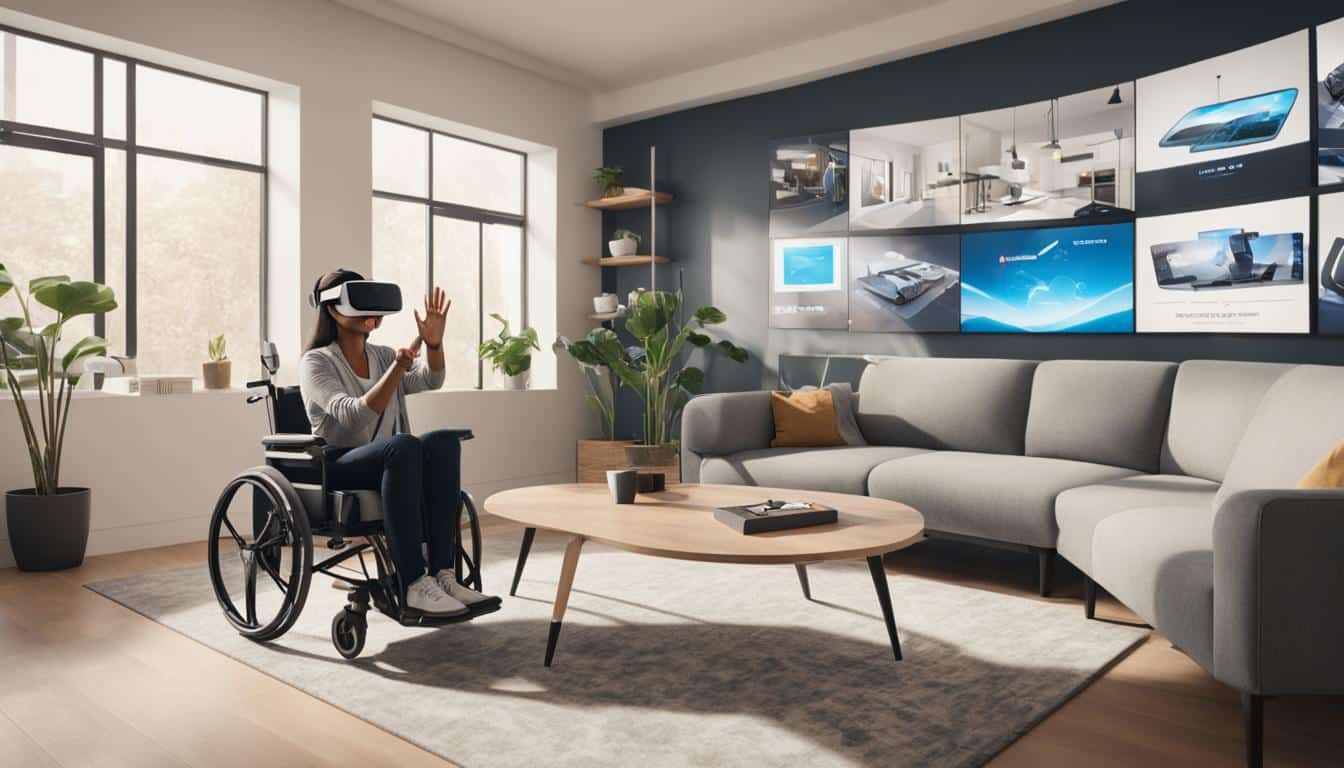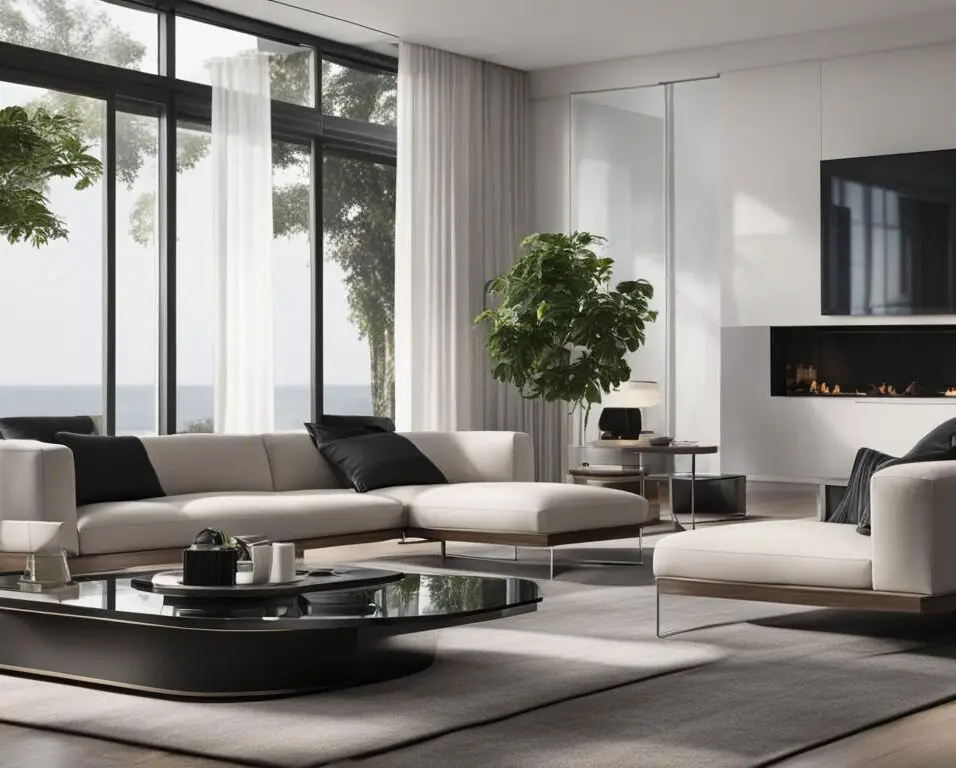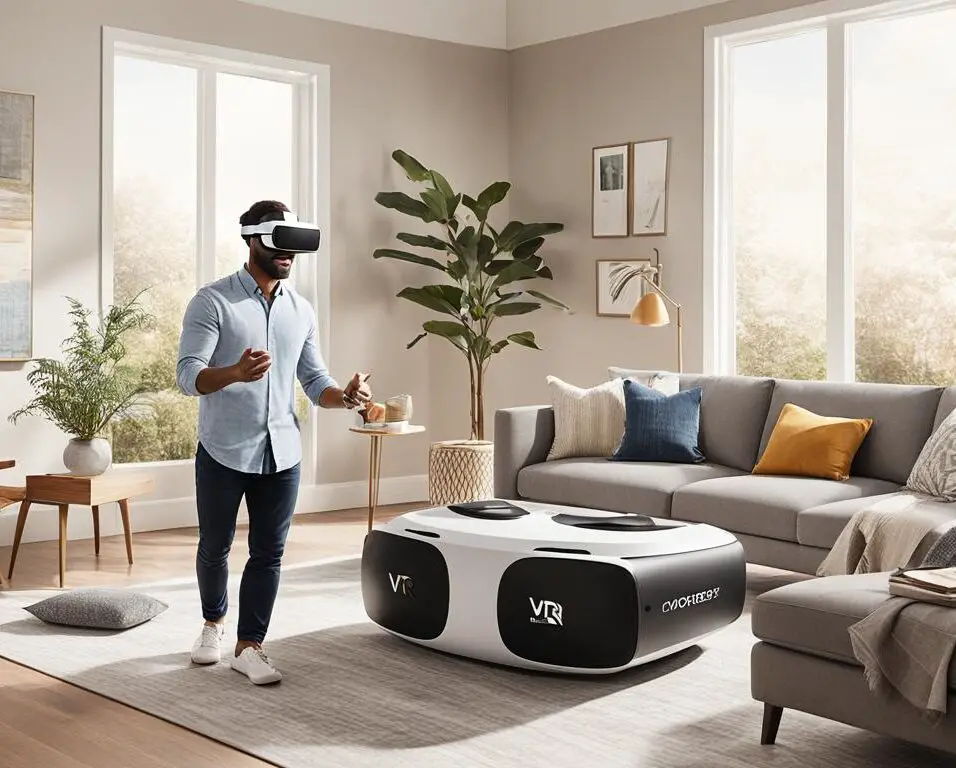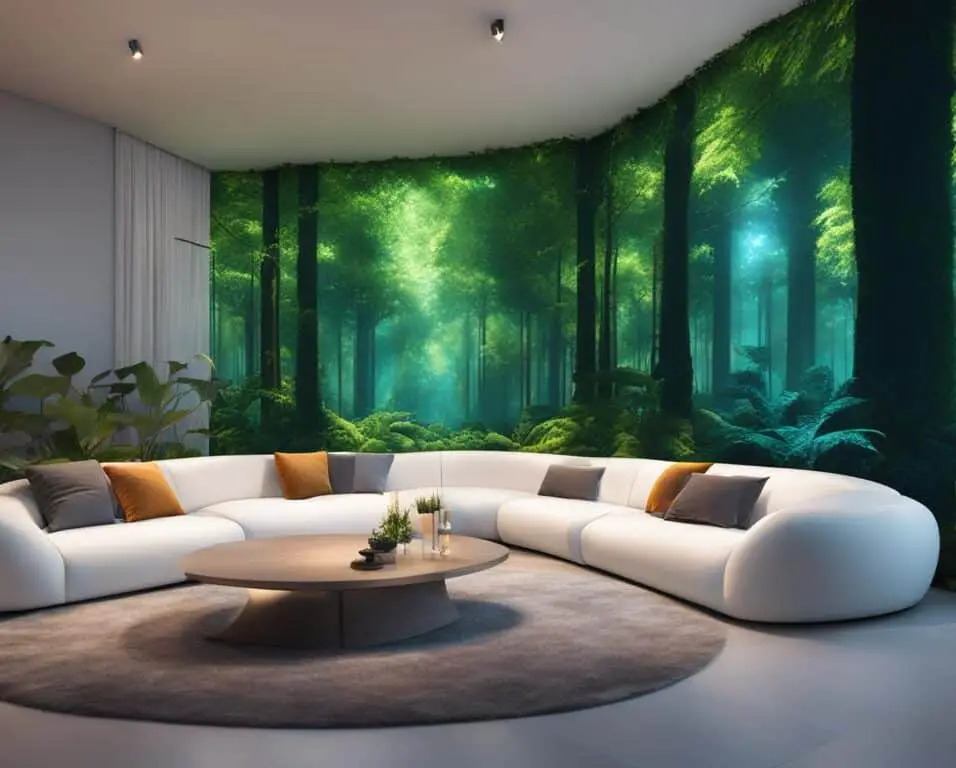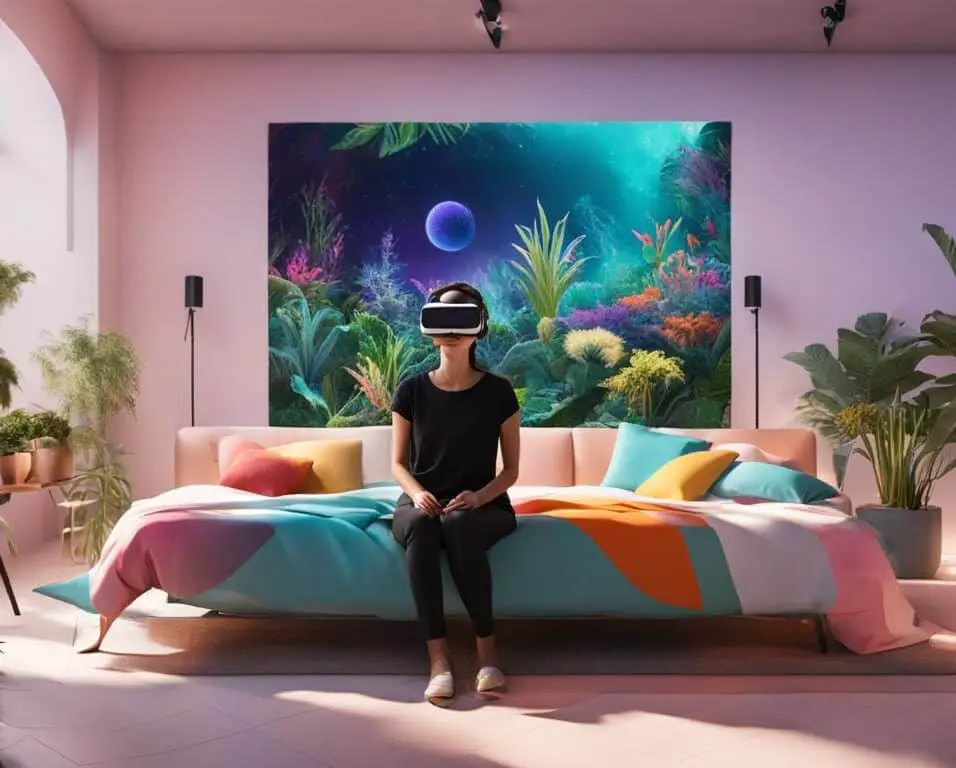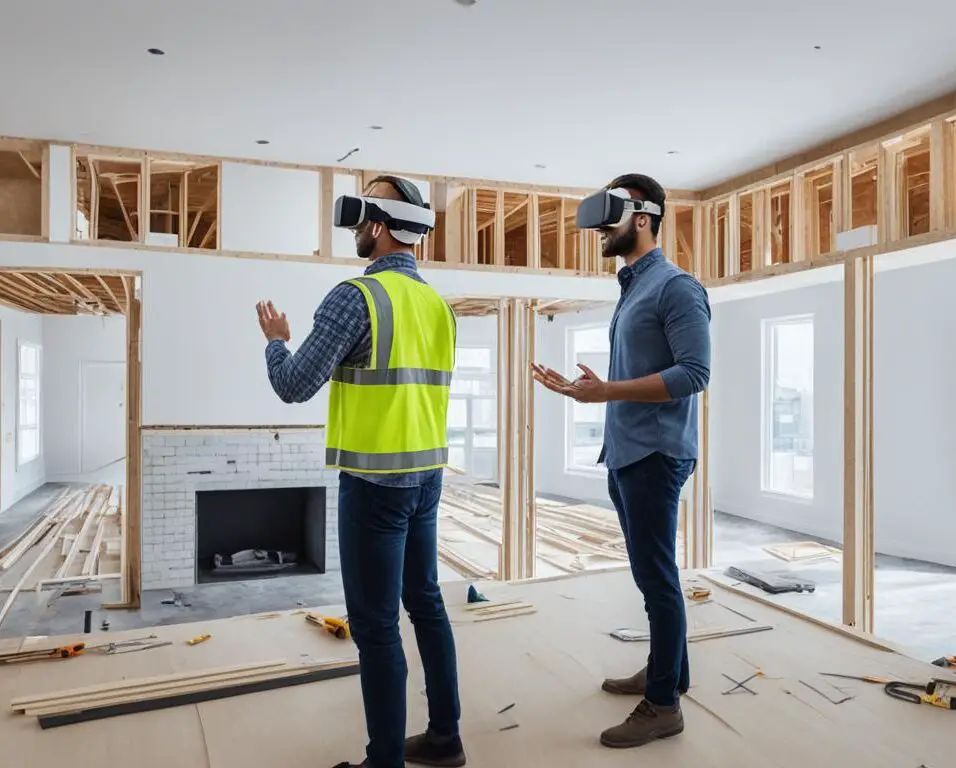Accessibility in Design: Using VR for Inclusive Spaces
VR technology is revolutionizing the field of home design by offering new possibilities for creating inclusive and accessible spaces for everyone. With the ability to visualize and experience spaces in a virtual environment, designers can now cater to the specific needs of individuals with disabilities and ensure that homes are designed for maximum accessibility and comfort.
Key Takeaways:
- VR technology enables designers to create inclusive and accessible spaces for individuals with disabilities.
- By using VR in the design process, designers can create virtual simulations of homes for an immersive experience.
- Personalized design solutions can be achieved through VR technology, catering to individual needs.
- VR technology helps enhance safety and security in home design by identifying potential risks.
- The future of accessible home design lies in the continued integration of VR technology.
The Power of Immersive Experiences
Virtual reality (VR) technology enables individuals to engage in immersive experiences within realistic and interactive environments. With the use of VR in the design process, designers can create virtual simulations of homes, providing users with the opportunity to explore and interact with the space from various perspectives.
This immersive experience offered by VR technology plays a crucial role in ensuring accessibility and usability in home design. By allowing users to virtually experience the environment, designers gain valuable insights into potential obstacles and challenges that individuals with diverse abilities may encounter.
“VR technology allows us to step into the shoes of those with different accessibility needs. It enables us to identify design flaws and make necessary adjustments to create spaces that are truly inclusive and accessible to all individuals.”
By exploring and experiencing the virtual environment, designers can identify areas where accessibility and mobility may be compromised and make the necessary modifications to ensure that the home design meets the needs of all users.
VR technology not only facilitates a deeper understanding of how individuals interact with spaces but also presents an opportunity for designers to collaborate more effectively with homeowners to create personalized and accessible design solutions.
Virtual Reality for Design Collaboration
With VR technology, designers can engage homeowners in the design process more actively, facilitating real-time collaborations and discussions within the virtual environment. Homeowners can provide feedback and input, considering factors such as their unique accessibility requirements, preferences, and daily needs.
This collaborative approach ensures that the final design caters to the individual needs of the homeowner, enhancing accessibility and inclusivity.
“Using VR technology, we can create a truly personalized design that reflects the unique needs and preferences of each homeowner. This level of customization ensures that the home design not only accommodates accessibility requirements but also reflects the homeowner’s personality and lifestyle.”
Overall, the power of immersive experiences provided by VR technology enables designers to design with a heightened sensitivity to accessibility, ensuring that homes are not only aesthetically pleasing but also functional, comfortable, and inclusive for individuals with diverse abilities.
| Key Benefits | VR Technology in Home Design |
|---|---|
| Enhanced understanding of accessibility needs | Close interaction with virtual environment enables thorough assessment of accessibility requirements. |
| Real-time collaboration | Homeowners can actively participate in the design process, providing input and feedback. |
| Personalized design solutions | VR technology allows for customizing designs to meet the unique needs and preferences of homeowners. |
| Increased accessibility and inclusivity | By designing with VR technology, homes can be made more accessible and inclusive for individuals with diverse abilities. |
Personalized Design for Individual Needs
In the realm of home design, one size does not fit all. Every individual has unique needs and preferences when it comes to their living space. This is especially true for individuals with disabilities, who require specialized design solutions to ensure accessibility and inclusivity.
With the advent of VR technology, designers now have the means to create personalized design solutions that cater to the individual needs of homeowners. By integrating VR into the design process, virtual representations of homes can be created, allowing for customization that fits the specific requirements of individuals with disabilities.
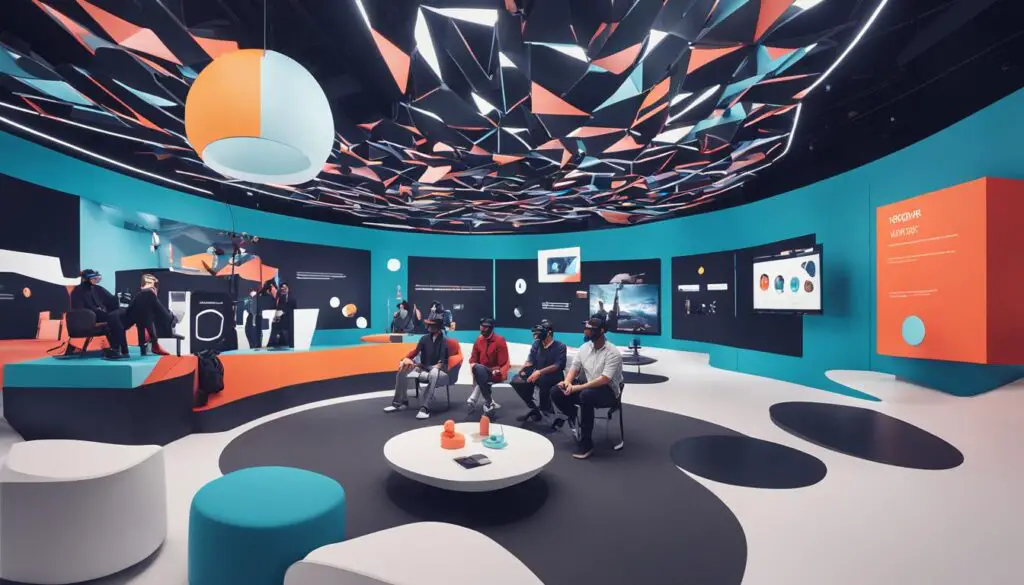
VR technology enables designers to explore and modify various aspects of the home, such as wheelchair-friendly layouts, accessible fixtures, and adaptive technologies that enhance mobility and independence. By tailoring designs to address the individual needs of homeowners, the overall accessibility and inclusivity of the home are significantly improved.
In this personalized design approach, VR technology serves as a powerful tool for collaboration between designers and homeowners. Through virtual simulations, homeowners can actively participate in the design process, providing feedback and making informed decisions that ultimately shape their living space. This level of involvement ensures that the final design meets their unique needs and fulfills their vision for an accessible home.
“Personalized design solutions empower individuals with disabilities by giving them greater control and autonomy over their living environment. By leveraging VR technology, we can create homes that not only accommodate their needs but also reflect their personal style and preferences.”
Furthermore, personalized design solutions extend beyond the physical aspects of the home. VR technology also allows designers to integrate features that promote emotional well-being and comfort. For example, customizable lighting options, calming color schemes, and spaces that cater to specific interests or hobbies can be incorporated into the design, enhancing overall livability and enjoyment.
In summary, personalized design using VR technology is a game-changer in the realm of accessible home design. By focusing on individual needs, designers can create homes that are truly tailored to the unique requirements of homeowners with disabilities. This customized approach not only improves accessibility but also fosters a sense of empowerment, autonomy, and well-being for individuals living in these personalized spaces.
Enhancing Safety and Security
When it comes to home design, safety and security are paramount. VR technology offers a powerful tool for enhancing both aspects in the design process. Through the use of virtual simulations, designers can identify potential safety hazards and security vulnerabilities, allowing them to make necessary modifications before construction begins.
The virtual environment created by VR technology enables designers to simulate various scenarios and visualize potential risks. By doing so, they can ensure that the design incorporates safety features such as proper lighting, clear pathways, and accessible emergency exits. This proactive approach to safety helps to prevent accidents and creates a secure environment for residents.
Furthermore, VR technology allows for the testing and implementation of advanced security systems. Designers can simulate the integration of smart home technology and surveillance systems, ensuring optimal placement and effectiveness. By leveraging VR technology, homeowners can have peace of mind knowing that their homes are equipped with state-of-the-art security measures.
“VR technology provides designers with the ability to simulate potential hazards and identify security vulnerabilities, resulting in safer and more secure homes.”
Take, for example, the case of John and Emily, a young couple designing their dream home. Through VR technology, they were able to visualize their home’s layout and identify potential safety concerns. They realized their initial design lacked proper lighting in certain areas and had limited visibility of entry points. With these insights, they made the necessary adjustments to improve safety and security, ensuring their home would be safe and well-protected.
By leveraging the power of VR technology in the design process, designers can go beyond traditional safety and security measures. This innovative approach allows for comprehensive risk assessment and the implementation of advanced security systems tailored to the specific needs of the homeowners.
Overall, VR technology enhances safety and security in home design by offering a virtual platform for risk assessment and the integration of advanced security technologies. It empowers designers to create homes that prioritize the safety and well-being of residents, providing them with peace of mind in their living spaces.
| Safety and Security Benefits of VR Technology in Home Design | |
|---|---|
| Simulating potential hazards and risks | Identification and mitigation of safety concerns before construction |
| Optimizing lighting and visibility | Enhanced security and reduced risk of accidents |
| Testing and integration of smart home technology | Improved security measures and convenience for homeowners |
| Simulation of surveillance systems | Effective security planning and implementation |
Through the use of VR technology, designers can create homes that prioritize safety and security, ensuring residents live in a secure and protected environment. By simulating potential hazards and implementing advanced security measures, VR technology revolutionizes the field of home design, creating spaces that offer peace of mind and protection to homeowners.
The Future of Accessible Home Design
As VR technology continues to advance, the future of accessible home design looks promising and exciting. Designers will have access to even more powerful tools and capabilities that will enable them to create inclusive and accessible spaces. VR technology opens up a whole new realm of possibilities for designing homes that prioritize accessibility and accommodate the unique needs of individuals with disabilities.
“The integration of VR technology in home design allows designers to create immersive experiences that offer valuable insights into the accessibility and usability of the space.”
One of the exciting advancements on the horizon is the use of haptic feedback in VR simulations. Haptic feedback technology can simulate tactile experiences, providing a more realistic and immersive understanding of how spaces feel and function. By incorporating haptic feedback into the design process, designers can enhance their ability to create spaces that are not only visually appealing but also physically accommodating.
Real-time collaboration in the virtual environment is another area where VR technology is making strides. Design teams can work together seamlessly, regardless of their physical location. This allows for greater collaboration and input from experts in accessibility and inclusive design, ensuring that every aspect of the home is carefully considered to meet the needs of all residents.
The integration of artificial intelligence (AI) is yet another exciting development. AI has the potential to analyze user preferences and needs, personalizing home designs based on individual requirements. This means that accessible design solutions can be tailored to suit different disabilities, creating homes that are truly inclusive and adaptable.
Future Features of Accessible Home Design with VR Technology:
- Use haptic feedback technology to simulate tactile experiences
- Enable real-time collaboration in the virtual environment
- Integrate artificial intelligence to personalize designs based on user preferences and needs
- Create homes that are adaptable and inclusive
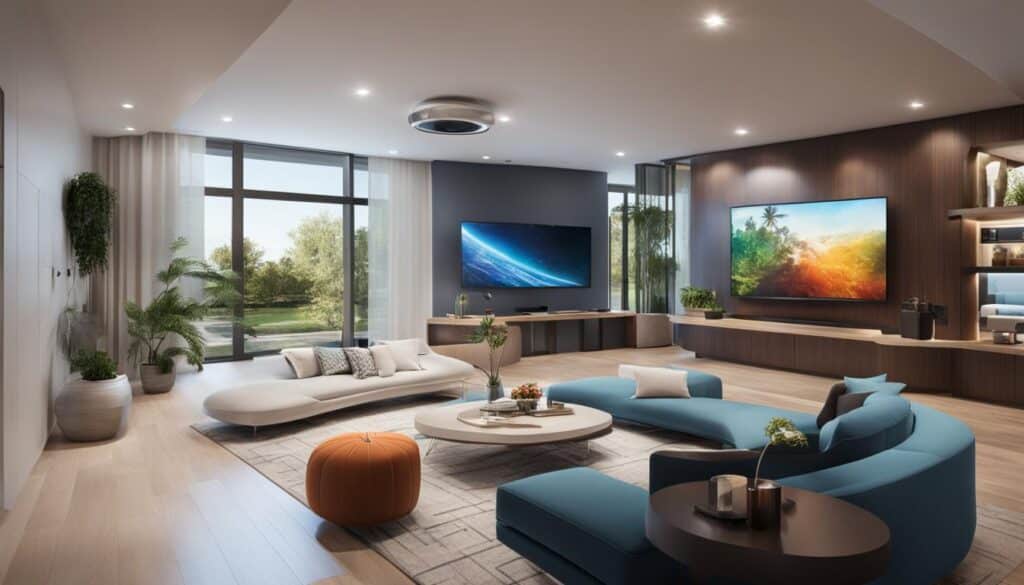
In conclusion, the future of accessible home design is undeniably intertwined with the rapid advancements in VR technology. By embracing VR, designers can revolutionize the way homes are designed, ensuring that they are accessible, inclusive, and tailored to the specific needs of individuals with disabilities. With haptic feedback, real-time collaboration, and artificial intelligence, the possibilities for creating truly accessible homes are endless.
Conclusion
In conclusion, VR technology is revolutionizing the field of home design by enabling designers to create inclusive and accessible spaces for everyone. With VR for Accessible Home Design Solutions, homes can be designed to meet the specific needs of individuals with disabilities, ensuring that everyone can live in a space that is comfortable, safe, and inclusive.
One of the key advantages of VR technology is its ability to provide immersive experiences. By visualizing and experiencing spaces in a virtual environment, designers gain valuable insights into the accessibility and usability of the design. This allows for necessary adjustments to be made to ensure maximum accessibility and comfort.
Moreover, VR technology allows for personalized design solutions that cater to the individual needs of homeowners. By creating virtual representations of homes, designers can customize layouts, fixtures, and technologies to enhance mobility and independence. This level of personalization greatly improves the overall accessibility and inclusivity of the home.
Furthermore, VR technology plays a crucial role in enhancing safety and security in home design. By simulating potential hazards and obstacles, designers can identify risks and make necessary modifications to eliminate them before construction begins. This ensures that homes are built with proper lighting, clear pathways, and accessible emergency exits, promoting the safety and well-being of residents.
The future of accessible home design lies in the continued integration of VR technology. As VR technology advances, designers will have access to even more powerful tools and capabilities. This includes haptic feedback for realistic tactile experiences, real-time collaboration in the virtual environment, and the integration of artificial intelligence to personalize designs based on user preferences and needs. With the continuous development of VR for Accessible Home Design Solutions, the possibilities for creating inclusive and accessible spaces are limitless.
FAQ
How is VR technology revolutionizing home design?
VR technology is revolutionizing home design by offering new possibilities for creating inclusive and accessible spaces for everyone. Designers can visualize and experience spaces in a virtual environment, allowing for catering to the specific needs of individuals with disabilities and ensuring maximum accessibility and comfort in homes.
What is the role of VR technology in the design process?
VR technology allows designers to create virtual simulations of homes, enabling users to experience the space from different perspectives. This immersive experience provides insights into the accessibility and usability of the design, allowing for necessary adjustments to ensure the home is accessible to all.
How does VR technology enable personalized design solutions?
By integrating VR into the design process, designers can create virtual representations of homes that can be customized to fit the specific requirements of individuals with disabilities. This includes features such as wheelchair-friendly layouts, accessible fixtures, and adaptive technologies that enhance mobility and independence, improving the overall accessibility and inclusivity of the home.
What is the impact of VR technology on safety and security in home design?
VR technology plays a crucial role in enhancing safety and security in home design. Designers can simulate potential hazards and obstacles in the virtual environment, identifying and eliminating potential risks before construction begins. This includes ensuring proper lighting, clear pathways, and accessible emergency exits. VR technology also allows for testing and implementation of advanced security systems like smart home technology and surveillance systems.
What does the future hold for accessible home design with VR technology?
The future of accessible home design lies in continued integration of VR technology. As VR technology advances, designers will have access to even more powerful tools and capabilities for creating inclusive and accessible spaces. This includes haptic feedback to simulate tactile experiences, real-time collaboration in the virtual environment, and the integration of artificial intelligence to personalize designs based on user preferences and needs.



